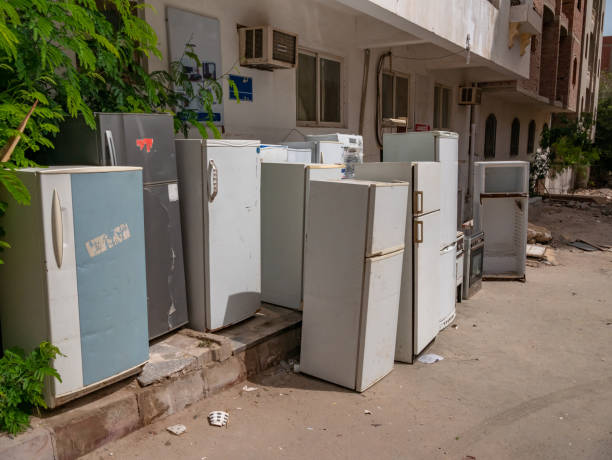Key Takeaways
- Proper refrigerator disposal helps prevent environmental harm and ensures compliance with relevant regulations.
- Recycling, donation, and professional removal services are practical options for disposing of old appliances.
- Refrigerators contain chemicals that can harm humans when disposed of improperly.
- Understanding local rules and energy efficiency rebates can save money and reduce environmental impact.
Why Responsible Refrigerator Disposal Matters
Old refrigerators often end up languishing in garages or basements, not only because they’re heavy and awkward to manage, but also because their disposal can feel intimidating. Yet, letting them sit idle or opting for improper disposal carries serious risks. Household fridges are packed with refrigerants, heavy metals, and insulation materials that, when not handled properly, can seep into soil, contaminate water supplies, and pollute the atmosphere. Utilizing a trusted service, such as https://www.1800gotjunk.com/us_en/what-we-take/refrigerator_removal, makes disposal easier and ensures that all environmental standards are met. These services are equipped to safely remove the unit, transport it for recycling, and handle its hazardous components responsibly, which helps homeowners protect not only their household but also their wider community.
The importance of responsible refrigerator disposal extends far beyond preserving curb appeal or reclaiming storage space. The U.S. Environmental Protection Agency notes that aging fridges frequently contain substantial amounts of substances harmful to both people and wildlife, such as polychlorinated biphenyls (PCBs) and mercury in electrical components. Additionally, these appliances may leak oil or refrigerants over time, posing ongoing risks even when left out of sight. Taking steps to dispose of the refrigerator through venues means you’re actively preventing pollution, promoting recycling, and staying in line with legal requirements that safeguard your family and neighborhood.
Hidden Environmental Impacts of Fridge Disposal
The environmental consequences of fridge disposal are often invisible, but they are far-reaching. Inside most older refrigerators are chlorofluorocarbons (CFCs) or hydrochlorofluorocarbons (HCFCs)—both powerful greenhouse gases with a high ozone-depleting potential. Even a small leak during disposal may release chemicals that persist in the atmosphere for decades, weakening the ozone layer that protects life on Earth from ultraviolet radiation. The issue is so significant that international agreements, such as the Montreal Protocol, exist primarily to phase out these hazardous substances.
If refrigerators are discarded without care, trash compactors or landfills can release additional insulation foam containing greenhouse gases. According to the EPA, a single improperly disposed refrigerator can emit up to 2 tons of carbon dioxide equivalent, which is roughly the same as running your car for half a year. When multiplied by the hundreds of thousands of refrigerators replaced annually, the environmental cost adds up astonishingly quickly. Choosing eco-friendly disposal protects against these impacts, ensuring that coolants and components are recovered, processed, or disposed of appropriately, rather than being released unchecked into our shared environment.
Safe Removal Options for Homeowners
Fortunately, there’s no need for homeowners to navigate appliance disposal alone. Many options exist to suit a range of needs and schedules, making responsible removal highly accessible. Municipal governments commonly organize large-item or electronics recycling days, where bulky appliances can be collected for a minimal or no fee at all. For those seeking a hands-off approach, private services can visit your home, haul away the old fridge, and provide assurance that the recycling adheres to all relevant environmental standards.
- City or Town Collection Events: Check your local waste management website for bulk waste event calendars or appliance drop-off points. Some towns even schedule door-to-door pickups for residents in need.
- Private Removal Services: These providers offer flexible scheduling and will physically remove the item from your property, often recycling as much as possible in the process.
- Retailer Take-Back: Many appliance retailers offer haul-away of your old fridge when you purchase a new model, sometimes even including it for free during promotions. Ask about similar programs when making your next appliance upgrade.
These solutions not only minimize hassle for the homeowner but also provide peace of mind, ensuring that eco-friendly and legal processes are followed. Always verify proof of compliance; most reputable services provide documentation or receipts confirming safe and certified disposal.
Steps to Prepare Your Old Refrigerator for Removal
- Empty the fridge: All food, drink, trays, and crisper drawers should be taken out. Unplug the appliance and allow ice to melt fully; this cleanup will prevent spills and mold growth during handling.
- Disconnect and defrost: Unplug your refrigerator at least 24 hours before scheduled removal. Leave the doors propped open slightly to allow air to circulate and moisture to escape. Lay down towels if your unit is likely to leak water from the melting freezer compartment.
- Secure the doors: Tightly tape or bungee doors closed, or remove them altogether. This important step eliminates a tragic hazard—children and pets sometimes climb inside discarded appliances and become trapped.
- Check for leaks: Carefully inspect the appliance for any oily fluids or discoloration beneath it. Leaks, especially around the compressor, might indicate trouble and may require professional attention to prevent chemical spills.
Preparing your fridge in this way not only makes the removal process safer for handlers but can also prevent costly cleanup or legal issues should leaks or accidents occur during transit.
Donation and Reuse: Giving Appliances a Second Life
Not every old fridge is destined for the scrap heap. If your appliance is still working, donating it could make a meaningful difference for a family, community kitchen, shelter, or nonprofit group. Organizations like Habitat for Humanity and the Salvation Army typically accept gently used refrigerators that meet certain age and energy standards. Before donating, research your chosen organization’s acceptance criteria—most list prohibited models, size restrictions, and other guidelines on their websites.
Arranging transport or pickup is the next step. Some charities offer free pickup within certain distances, though others might require items to be dropped off. Clean the appliance thoroughly, secure loose items inside, and unplug it for at least a day before handing it over. By choosing to donate, you help keep usable resources in circulation and support valuable missions in your neighborhood, making sustainable choices that ripple benefits beyond your household.
Energy Efficiency and Rebates for New Appliances
Advancements in appliance technology have led to significant energy savings for homeowners. The U.S. Department of Energy emphasizes that modern ENERGY STAR-certified refrigerators use about half the energy of those built just two decades ago. It can translate into annual electricity savings of $50 to $100, depending on your usage and local utility rates. Over the typical lifespan of a fridge, these savings add up—and they help shrink your household’s carbon footprint, too.
To further encourage eco-friendly upgrades, many local utilities and appliance manufacturers offer rebates or discounts to customers who replace old, inefficient models with approved new ones. Some programs even provide free pickup and recycling of your previous appliance, removing yet another barrier to responsible disposal. Be sure to check utility company websites or ask retailers about eligibility for current rebate programs before finalizing your purchase.
Understanding Local Laws and Regulations
Laws concerning refrigerator disposal are designed to protect public safety and the environment. Many jurisdictions prohibit leaving appliances, such as refrigerators, at the curb without proof that all hazardous chemicals have been extracted according to strict federal or state protocols. Failing to follow these rules can mean hefty fines, penalties, or rejection by waste haulers.
Municipal waste departments, city websites, and recycling centers generally publish easy-to-follow guidelines explaining how to prepare and schedule your disposal. Some communities require that you remove the refrigerator’s doors for child safety, while others demand that drop-offs occur only at designated sites with licensed facilities. Call ahead or browse online to stay informed about these rules, which are periodically updated in response to changing environmental standards.



